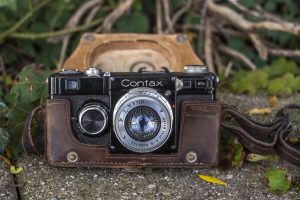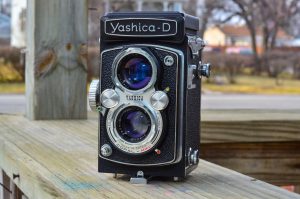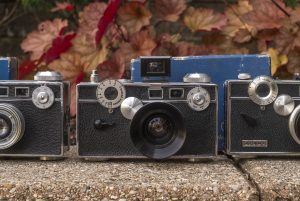Earlier this year a group of film photography bloggers had the idea where each of us would write an article discussing our five favorite cameras, and sharing them all together and see what we came up with. Never one to miss out on the opportunity to discuss some of the best cameras I’ve ever used, I decided to create my own “best of” article and share the five cameras I’ll take with me to the grave.
Each of the other articles in this series can be read here:
Aperture Preview – https://www.aperturepreview.com/dead-hands-cameras-five-cameras-i-will-never-part-with
Kosmo Foto – https://kosmofoto.com/2024/05/five-film-cameras-ill-never-part-with
Canny Cameras – https://austerityphoto.co.uk/dead-hand-cameras/
Photo Thinking – https://photothinking.com/2024-05-05-dead-hand-camera-list/
Alex Luyckx – http://www.alexluyckx.com/blog/2024/05/06/dead-hands-cameras-five-cameras-i-wont-let-go-of/
Jim Grey – https://blog.jimgrey.net/?p=90527
Camera Go Camera – https://cameragocamera.com/2024/05/06/dead-hands-cameras-my-top-five-cameras-i-wont-part-with/
In no particular order here are my five cameras that I will never part with.
The first camera on this list is an easy selection, the Nikon F2AS is a later version of the Nikon F2 with the DP-12 interchangeable prism. Take any F2, and add to it a DP-12 and you have an F2AS.
The F2 itself was an evolutionary update to the original Nikon F and was released in 1971, twelve years after the original F. As the most successful and influential SLR of its era, the Nikon F2 had big shoes to fill as Nippon Kogaku didn’t want to destroy the goodwill they had built with their first SLR, so rather than starting over with an entirely new camera, they took what was great about the Nikon F, and improved it with the F2.
While there are a huge number of internal changes, for me, there are three improvements which in my opinion make it a drastically better camera than the Nikon F. This first, is an ergonomic redesign of the shutter release, which relocates it to a much more comfortable position nearer the front edge of the top plate. This might sound trivial that a single button can make a camera dramatically better, but it does. The entire ergonomics of the camera change when you have to reposition your hand to comfortably hold it and that’s what happened here.
The second change is the relocation of the battery compartment from the viewfinder to the body. Since both the Nikon F and F2 are mechanical cameras and power is only needed for the meter which is located in the viewfinder, there was a logic to the original F having the battery in the viewfinder. The problem with that was it made it look ugly and top heavy, and it also meant that none of the camera’s electronics could be located in the body, plus the battery was difficult to change. Another change to the electronics was that now the F2 used more commonly available 1.5v silver oxide or lithium batteries which are still available today, instead of the early mercury PX625 batteries of the original Photomic F finder.
A third and final change is to the film compartment, which switches to a more traditional hinged back instead of the removable back of the Nikon F and earlier rangefinders. Although removable backs were very common in the mid 20th century, by the 1970s when the F2 was released, always having to set aside the back and not drop it, while changing rolls of film was inconvenient.
Other changes such as the addition of a new top 1/2000 shutter speed, a more traditional mirror lock up lever, and in the case of the DP-12 finder, support for Nikkor Ai (automatic indexing) lenses, and an LED display in the viewfinder round out one of the most advanced, and capable 35mm SLRs ever made.
I have many Nikon SLRs and I love using most of them, but if it really came down to it, I think the F2AS is my favorite Nikon SLR and perhaps one of my favorite ever. I could not imagine ever parting with it.
Second Chance Substitute: Nikon FM2n because other than the interchangeable viewfinder, shares almost all of the same features I love about the F2AS in a smaller body.
My review of the Zeiss-Ikon Contax I
I doubt anyone will disagree with my choice of the Nikon F2 as one of the greatest cameras I own, but this next one might take a bit of explaining. The Zeiss-Ikon Contax I rarely shows up on anyone’s list of top anything cameras. It is a camera that was superseded in performance and quality by later Contaxes, and depending on how you look at it, other interchangeable lens rangefinders by Nikon, Leica, and many other companies.
My reasoning for the Contax I is two fold. For starters, this camera works perfectly. In 2021, it received a full CLA from Radu Lesaru at 3R Cameras, getting new curtain straps, a totally disassembled, cleaned, lubed, and adjusted shutter mechanism, rebuilt rangefinder with new coupling string, a viewfinder cleaning and rangefinder calibration, and the removal of “Zeiss Bumps” on the back door of the camera. I cannot prove this, but this particular Contax I could possibly be the best condition and most fully functional Contax I anywhere in the world.
Beyond its condition, a reason I love this camera so much is because to me, it signifies everything I enjoy about collecting and shooting old cameras. I am not a photographer, and I am not strictly a collector. I consider myself somewhere in between. A person who appreciates the history, the design, the functionality, and the use of old cameras and lenses equally. The Contax I has a design unlike any other camera (even later Contaxes) it is historically significant, it is a ton of fun to shoot, and it delivers excellent images. I only have 50mm lenses in the Contax mount, but in the event I want to go wider, Nikkor rangefinder or Soviet Kiev lenses will suffice.
The Contax I doesn’t rank at the top of any camera in any one particular category, but when looked at as a whole, considering its age, history, performance, and looks, it is definitely a camera I don’t ever see myself parting with.
Second Chance Substitute: Nikon S2 as it shares much of the same characteristics as the Contax, uses most of the same lenses, is a bit more modern, and is equally fun to shoot.
If the Nikon F2AS is my best SLR for its mechanical, ergonomic, and reliable superiority, the Pentax LX would be my go to camera as an electronic camera with auto exposure for the times I want it. I have many cameras with a similar feature set to the LX including the Nikon F3 which the Pentax was considered a primary competitor to, so my options are wide open in this category of camera, but where many AE SLRs with electronic shutters tend to lean towards “generic” and uninspiring operation, the Pentax LX is a set up in terms of usability and “fun factor”.
Little features like the cool reflective viewfinder scale whcih can be seen in poor lighting and that the film counter winds forward and backwards while rewinding in case you want to get creative with double exposures adds to the camera’s appeal. It also doesn’t hurt that aside from the Nikon F-mount, the Pentax K-mount which this camera uses is probably the second most common bayonet lens mount out there. Zillions of K-mount lenses have been made and some even work on later Pentax DSLRs if that’s something you’re interested in.
If you’ve never handled a Pentax LX before, it is a step above the many other excellent Pentax K-mount SLRs. Make no mistake, this was a pro camera, with interchangeable viewfinders, data backs, and even a neat four-post system on the front of the camera allowing you to attach accessories to the left and right side of the camera.
Shooting the Pentax LX certainly won’t guarantee better images, but it definitely does everything it can to set you up for success, plus, it’s a heck of a lot of fun to use. For those reasons, the LX deserves a spot on this list.
Second Chance Substitute: Olympus OM-2 or OM-4 as both these cameras are equally fun to shoot and are loaded with many features. The one knock against the Olympuses is that I have far fewer lenses in the OM-mount.
I’m going “old school” for this next one. As the only medium format entry in this list, the Yashica D makes the cut off for cameras I never want to part with. In the years since I added this camera to my collection, I have come across many other equally good TLRs, many of which have the same feature set, better lenses, and even longer lists of features.
So why keep the lowly Yashica D? My reason is that although there are a huge number of excellent TLRs worthy of keeping, many of them over complicate the art of the shot. The Yashica D is a simple camera, it doesn’t have a meter, it doesn’t have an automatic film stop, it doesn’t even have a film advance lever. The Yashica D is quite basic, but therein lies the best part about this camera, is that there is very little to go wrong.
Comparing the Yashica D to many of the Rolleiflexes I have, or even a more advanced Yashica like the Yashica-Mat, on those cameras you can feel the inner parts of the camera moving each time you wind the film, changing shutter speeds and aperture f/stops causes dials above the viewing lens to move, models with exposure meters have additional complexity for the battery compartments and meter coupling. In each instance, there’s more to go wrong.
Not with the Yashica D. This is a simple, yet modern TLR, that I would be willing to bet that whoever owns this camera after I do pass on to the great aperture in the sky, this Yashica D will far outlive me.
Two additional pluses for this particular Yashica D, is that it is a later version with the upgraded 4-element Yashinon lens. Earlier Yashica-D TLRs came with a Yashikor triplet, which is still a fine lens, but the upgraded Yashinon on this D puts it in the same optical league as Tessar equipped Rolleis. In addition it has one of the brightest viewing screens of any TLR I’ve used. Later Yashica TLRs benefitted from the brighter, and more advanced laser etched Fresnel focusing screens allowing you to focus this camera in poor light, with ease.
I like many TLRs, but I fell in love with this Yashica D in 2015 when I first got it, and since then, I haven’t found one I love more.
Second Chance Substitute: Minolta Autocord, because even though it’s a bit more complicated than the Yashica D, it is still a pure and simple camera to use with an excellent take on focusing the lens. Viewfinder brightness and lens quality is equal as well.
My review of the entire Argus C-Series
In what might be the most surprising camera on this list, yep, I’m including the Argus C3 on the list, but not just any Argus C3, but one equipped with the Enna Werk Sandmar 35mm lens.
Why such a rudimentary camera you ask? I don’t actually know how many cameras I own, but the number is high. If I had to pare my collection down to just 5 cameras, I would want to be sure that at least one of them would always work, no matter the circumstance. Something that would survive the apocalypse. If cockroaches were to genetically mutate with human DNA and one day need to shoot film, I believe the Argus C3 is the camera that would still be working. Although each of the other 4 cameras on this list have a positive reputation for reliability, it is doubtful any of them will outlast the Argus C3.
And why specifically do I want one to have the 35mm Sandmar? For as good as the 50mm Cintar f/3.5 is, the Sandmar is not only optically better, but it also more closely approximates the angle of view for how I see the world. I’ve actually realized I see closest to 40mm, but 35mm is close enough. With the Sandmar and an auxiliary viewfinder on a C3, it effectively becomes a focus free snapshot camera for everything except closeups.
In addition to its ultimate reliability and great lens, the C3 also checks off some of the same boxes the Contax I does, in that it is full of history, it is one of the most popular American cameras ever made and is something that as an American, I feel connected to.
As I write this, I haven’t yet seen the “Dead Hands” articles written by the other bloggers at the top of this article as we’ve all agreed to release them on the same day, but I am certain the Argus C3 is not going to appear on any one of their lists, and that’s OK with me! Edit (after this was posted): I was right!
Second Chance Substitute: Kodak Hawkeye Brownie, as this is a camera that has proven “apocalypse” cred, appearing as the camera of choice in the video game and recent Amazon TV series, “Fallout”. The Hawkeye Brownie is another camera that is so reliable, even ghouls and Vault-Tec survivors will still be using one hundreds of years from now…I just gotta make sure I save some 620 spools.









Hmmm, I’ll play:
Leica M6
Nikon FE
Nikon F4
Hasselblad 500CM
Mamiya RZ67
Nikon FE
Voigtlander Perkeo II
New Mamiya 6
Canon 3000n
Fuji 645s
Linhof tecknika
Nikon f2
Rollei sl66
Pentax spotmatic
Olympus xa
Two Nikon F bodies, one plain prism and one Photomic FTn
Teo Nikon F2 bodies, one plain prism and one F2AS
One Argus C3